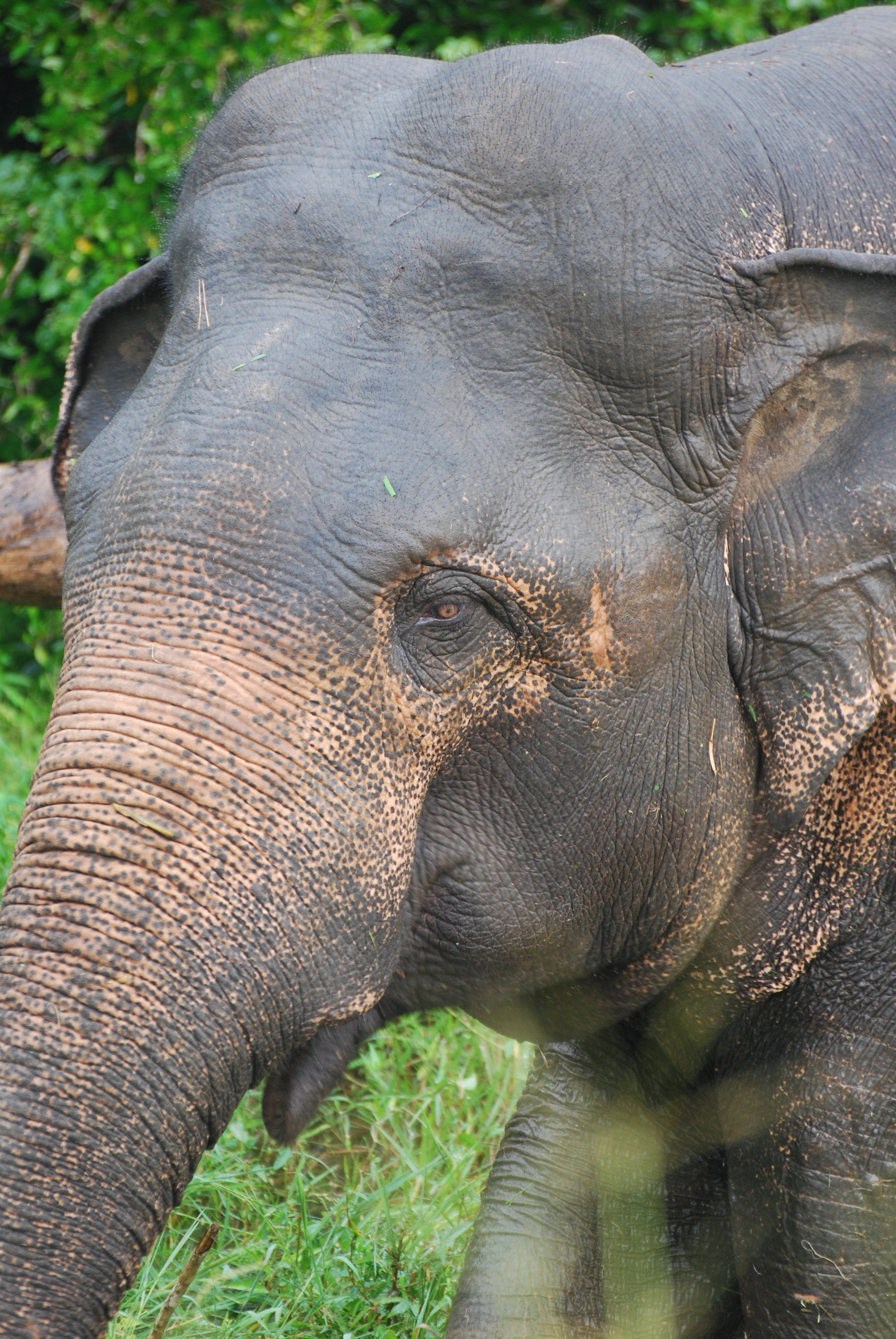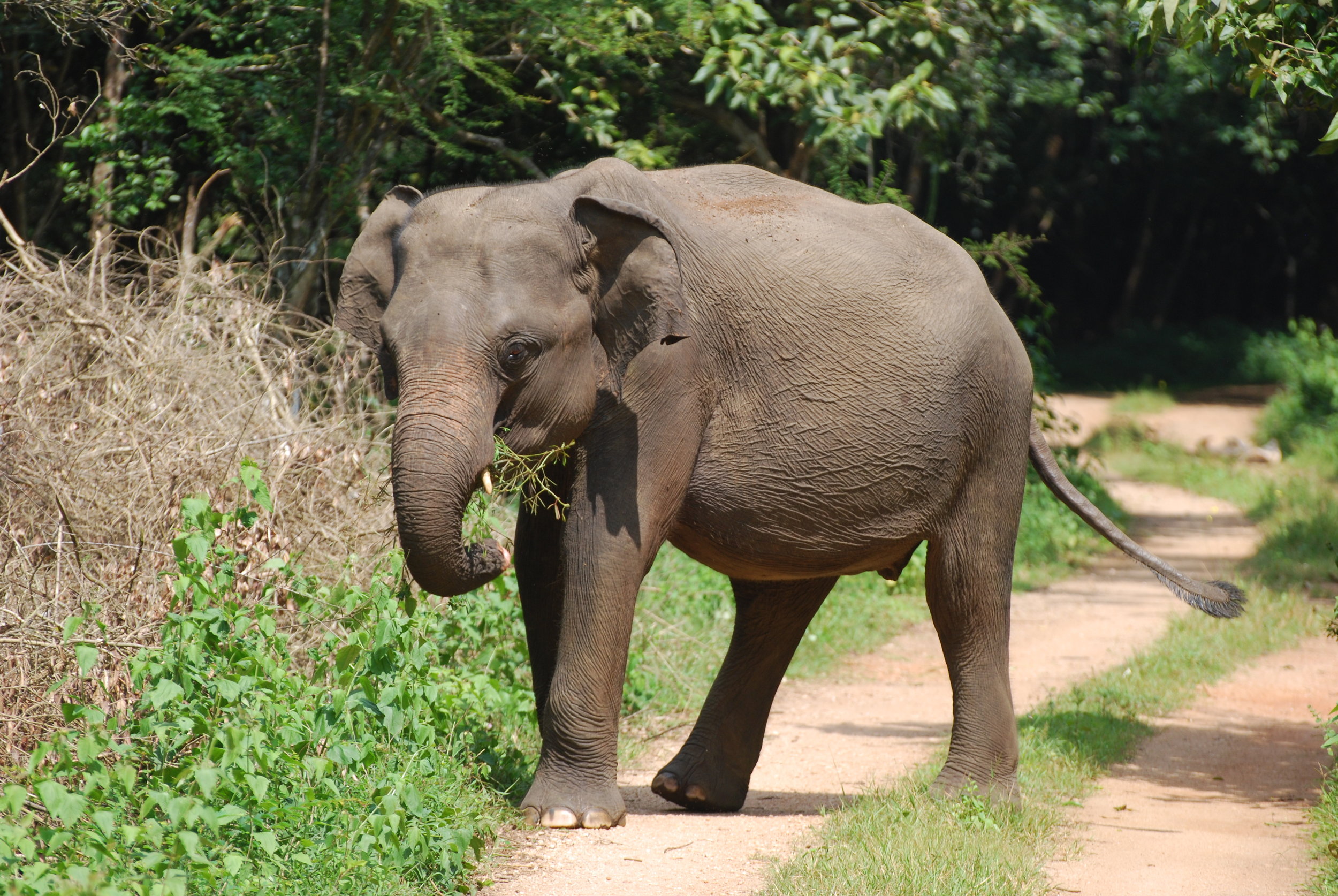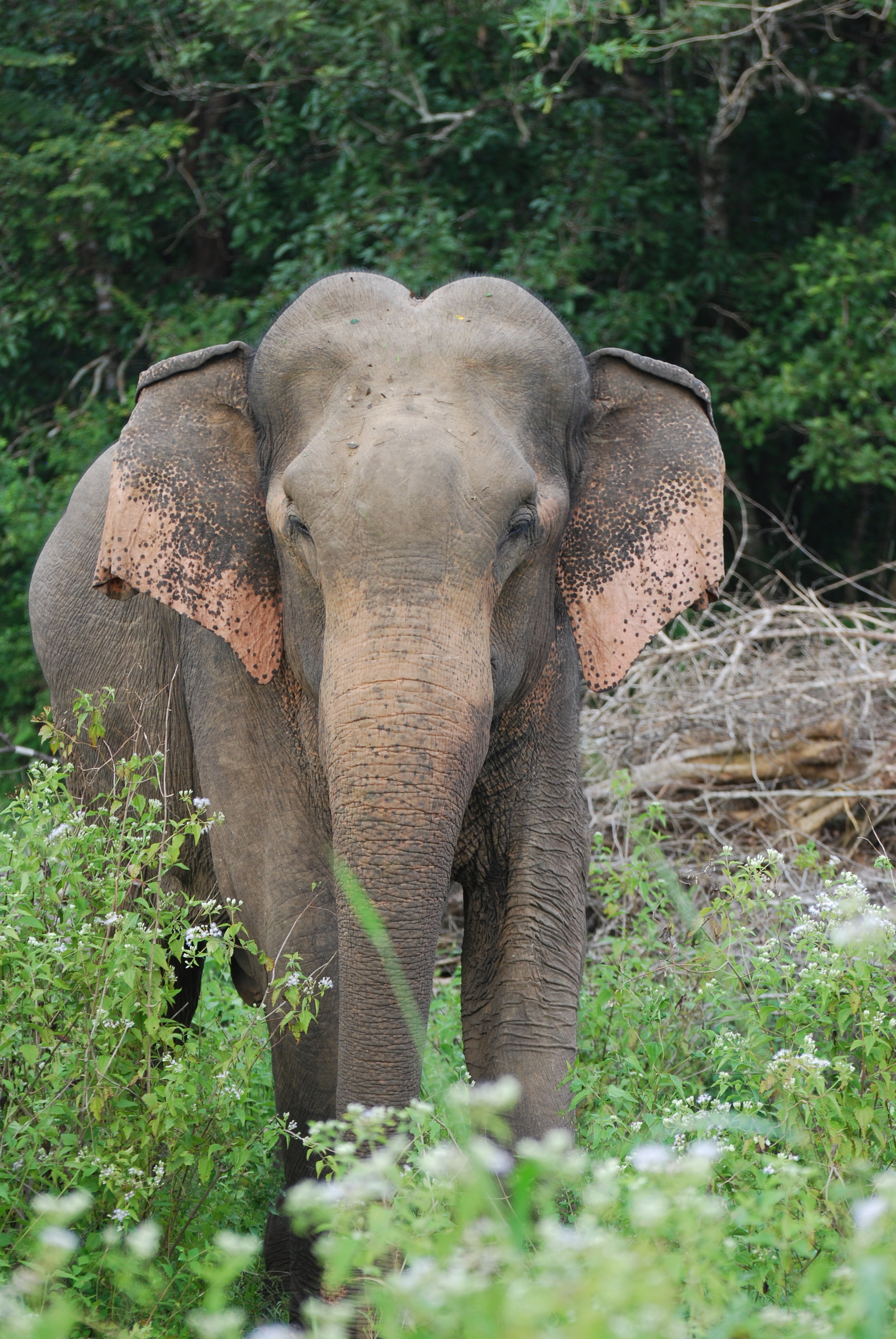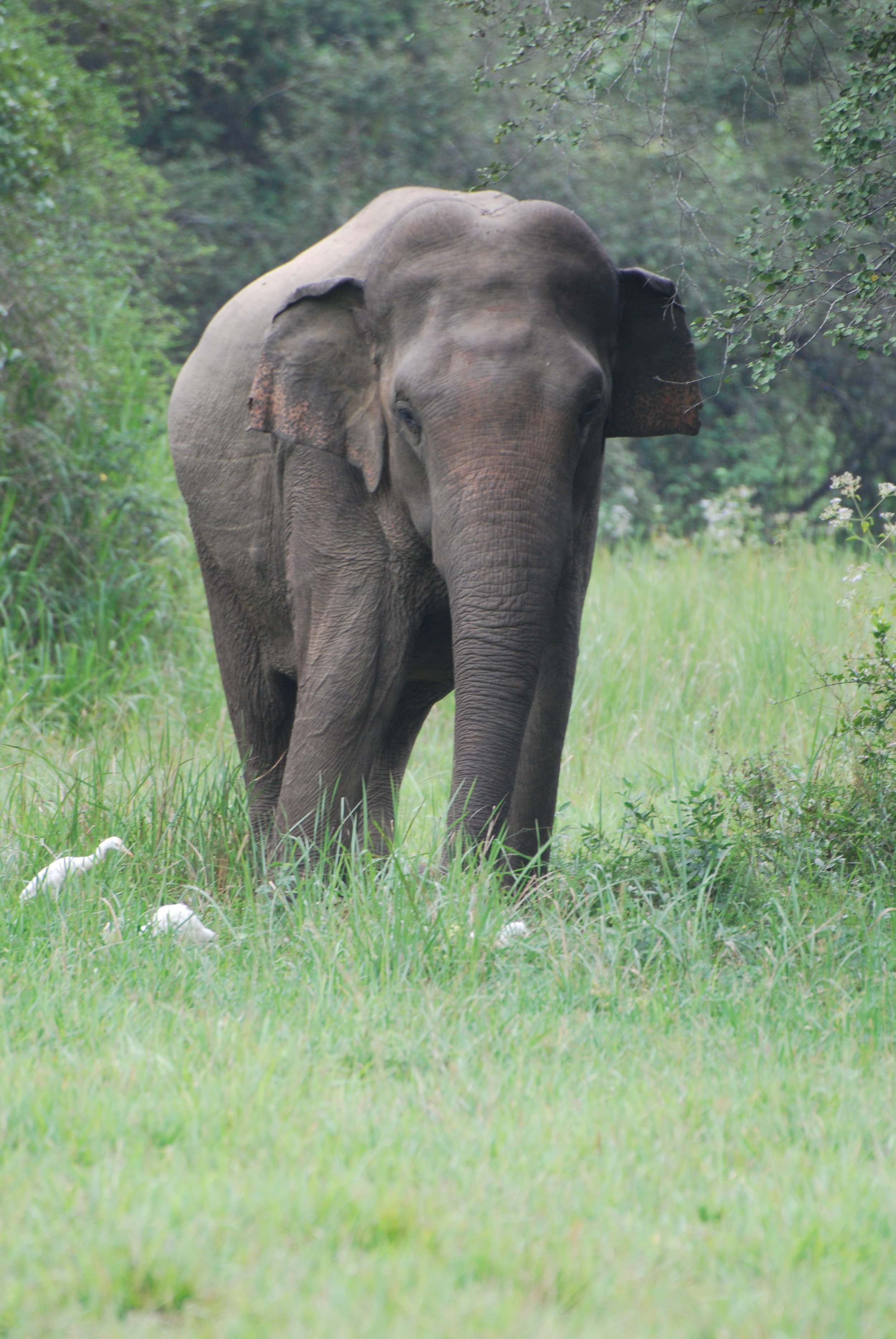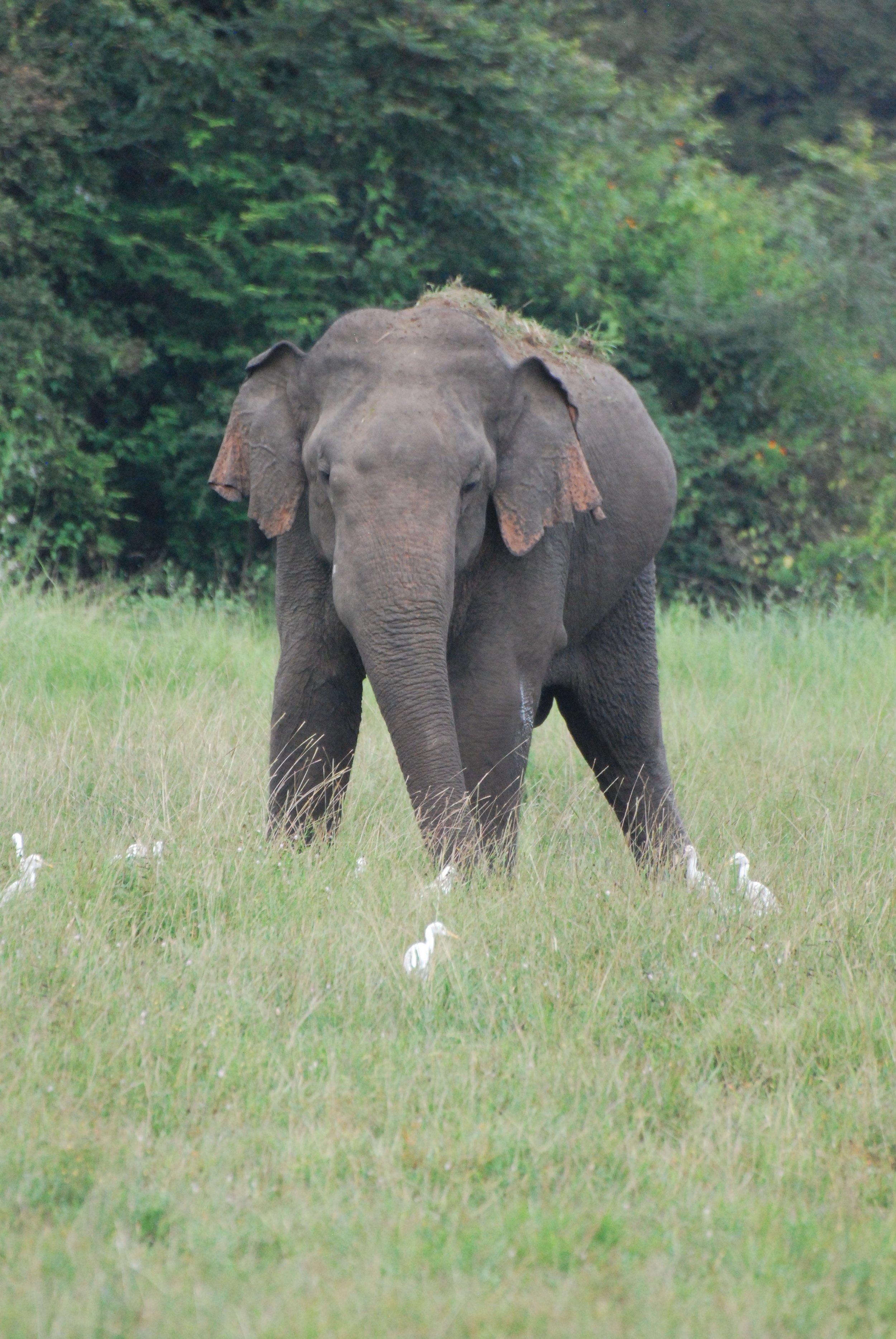I spent the past week running all sorts of errands that I can’t finish when I’m in the field. That means this week has consisted of a whirlwind of long-ignored (but not forgotten) emails, ensuring laboratory supplies and equipment are in place for our first batch of extractions to take place next week, and even a two-night trip to Colombo. My modus operandi is to keep busy like this, but I’ve found myself missing the slower pace and the elephants back at Wasgamuwa National Park. To date, we’ve had 1,187 elephant sightings over 186 different sighting events. With all of these sightings, we’ve identified 48 different adult male elephants (often called bulls; females are called cows). We’ve seen 24 of these bulls multiple times.
For this update, I thought I’d share a few of the bulls that we see often enough to be named. Upon being photographed, each bull is given his own three-digit identification number. Occasionally (although much more rarely now), we inadvertantly give a bull two different ID numbers, mistakenly thinking that a subsequent sighting is a new bull. We catch these cases upon careful review of our photographs every few days. In these cases, we combine the sightings for a single bull using his original ID number. His newer, mistaken ID number is retired so that some forgotten record isn’t treated as a different elephant when we analyze data in the months to come. Other times, we’ll review the photographs and realize that we can’t possibly identify that elephant again because the quality of our photos are so poor. Those numbers are retired too. So that means with 48 elephants, we’ve gone from ID numbers 001 to 060. We collate the best identifying photos for each bull into an ID card. We carry the ID cards bound together in the field with us so that we can more easily identify males in the field. This is the part of the job that I’ll never again take for granted when working with zoo elephants: in this regard, it’s much easier to know that your focal animal will be there when you want it, and you’ll know for sure it’s them.
An example of one of the ID cards we use in the field. Red arrows point on distinguishing marks. Age category 3 corresponds to an estimated age of 30-40 years. The date listed is the first date spotted.
And there are times when we see particular bulls so often—or they have physical features that are so easily distinguishable—that we give them names that are easier to remember than numbers. Some of these names are pop culture references, and a few come from loved ones or other important people back home. We’ve only named eight bulls so far. Sachintha and I are working on coming up with Sri Lankan names that honor important figures and scientists that come from the island (and, at my request, they have to be easy enough to pronounce and spell that I won’t resort to using the original ID number instead). We only name male elephants because of the scope of my study. Unfortunately, this means that many important female figures are overlooked. I guess I’ll just have to move back to studying female elephants one day so that they’re honored appropriately.
I should also emphasize here that these names (and in fact, even the ID numbers) are purely for our own use and convenience. That means none of these names are official; we don’t run them by any sort of authority, and they’re not recorded anywhere by anyone else. We haven’t named as many elephants recently because we haven’t seen as many new elephants repeatedly, as I discussed in the last post. When I head back into the field this Tuesday, I’m hoping that we begin naming elephants more frequently again.
So, here are some of “our” elephants that we regularly see in Wasgamuwa:
Arnold (001)
First spotted 18 December 2018
Arnold (male 001) in heavy musth. Those reddish patches on the side of his head? Those are temporal gland secretions that communicate his condition to females and other males. Wasgamuwa National Park, 26 Dec 2018.
I’ve written previously about Arnold, as he was the first bull we named (after Arnold Schwarzenegger, for his “toughness”). On our first 10-day trip to Wasgamuwa, we saw Arnold every day, often multiple times each day. He was deep in musth, draining continuously from his temporal glands and dribbling urine constantly (I never said musth or my work was glamorous, okay?). We never observed overt aggression from Arnold, but if another male approached the group of females we was with, almost immediately he would walk towards that male to escort him away—and it always worked. Since that trip, we’ve only seen Arnold once, on 30 January. As expected, he was no longer in musth, but we spent less than a minute with him. The sighting was early in the morning, and he immediately crossed the road we were traveling on to move between forest patches, where we could no longer see him. Maybe musth gave Arnold the confidence to be around us more frequently? Who knows, but I hope we see him again soon. More selfishly, I want to get another fecal sample from him; we got a couple from him when he was in musth, so it would be great to be able to compare the hormones of the same male in and out of musth (something we haven’t yet achieved with any of the other males either).
Maybe he’s born with it, maybe it’s…musth? Wasgamuwa National Park, 26 Dec 2018.
James (male 007) showing his distinctive coloration. Wasgamuwa National Park, 19 Dec 2018.
James (007)
First spotted 19 December 2018
James was named purely as a joke (his ID number is 007…get it?), but we’ve since seen him so often that I’m sure we would’ve named him anyway. James tends to exhibit more aggressive behavior than the other males, even before he recently came into musth (on our second-ever day in the field, he charged our vehicle from a short distance). He’s an easily distinguishable male, with depigmentation on his ears and “collar.” He’s also missing the last third of his tail, a not-so-uncommon occurrence. We’re never sure how elephants lose bits of their tails, but most likely, it’s due to an unpleasant interaction with another elephant. Did I not mention that elephants aren’t always the peaceful creatures we like to watch on television and in the movies?
Kevin (018)
First spotted 20 December 2018
Kevin (male 018) on a day he was particularly interested in our vehicle. Wasgamuwa National Park, 23 Dec 2018.
Kevin is probably our most spotted bull, and he’s easily become my favorite. His name has a personal connection to me. Less than two weeks before I left for Sri Lanka, my Uncle Kevin died, mostly unexpectedly. My uncle often served as my respite at family functions; we often exchanged glances from across the room in response to something crazy one of our (beloved) family members just said. He was also one of my godparents. I was fortunate to be home in Dallas when he passed so that I could say goodbye and be with family during the week’s events, but I think of him often here, having left to go overseas while I was still processing everything. I consider it an honor to name an elephant after a person, and so this was my way of honoring my uncle. For what it’s worth, I waited as long as I could before finding an elephant to name “Kevin,” waiting to observe something that reminded me of the human Kevin. Our elephant Kevin interacts calmly with other elephants, quietly moving between males and females, much like my uncle did with our family during holiday events. And I’d be lying if I said that the bulky stature of elephant Kevin wasn’t reminiscent of my uncle. So I smile every time we get to see Kevin, and he’s even approached our vehicle a few times, just standing there, seemingly watching us as we watch him. We last saw Kevin a few weeks ago, when he had just gone into musth.
For over a week, we thought Kevin’s depigmentation was limited to his ears. Then one day it rained, washing all of the mud and dirt that had covered his face. Boy, were we wrong. It turns out he has this beautiful pink pattern that covers much of his face. Wasgamuwa National Park, 27 Dec 2018.
A special moment: Kevin approaches our vehicle and just watches us for a bit. Wasgamuwa National Park, 21 January 2019.
Mason (023)
First spotted 24 December 2018
Mason (male 023) walking towards our vehicle. Notice the pink splotches of depigmentation that are isolated to the tips of his ears. Wasgamuwa National Park, 11 Jan 2019.
Mason is a young elephant (I estimate him to be about 10 years old), and we’ve seen him interact with a few bulls around his age. He’s easily spotted because of the unique pink patterns present just on the tips of his ears. He was named after my home university, George Mason University, when Elizabeth and Wendy came to Sri Lanka for their visit; both Elizabeth and Wendy earned their PhDs at GMU in the same program in which I’m currently enrolled, and Elizabeth is a tenured Associated Professor in GMU’s School of Integrative Studies. I appreciate the support I’ve received while at GMU, so it was only appropriate that an elephant be named in honor of all the people who make the university great. The real George Mason, after which GMU was named, wrote the Virginia Declaration of Rights, which was the basis for the US Bill of Rights. So I guess add having an elephant named after him to George Mason’s list of accomplishments.
Mason (male 023; right) socializing with a female. Wasgamuwa National Park, 24 Dec 2019.
Gimpy (038)
First spotted 11 January 2019
Gimpy (male 038) not looking so gimpy. Wasgamuwa National Park, 20 Jan 2019.
Gimpy was named based on his appearance, not in any sort of effort to be offensive. We first encountered Gimpy and thought he was dead or dying because he was laying down out in the open, something we knew was very unusual for an adult elephant to do in the middle of the day. After about 10 minutes of us worrying, Gimpy stood up, revealing the cause of his unusual behavior: his right wrist was very swollen and he was unable to bend his foot forward. It seems that a gunshot caused the injury, although we’re not sure. We made sure to tell our tracker to tell the authorities at the Department of Wildlife Conservation, but they were already aware, having scheduled a veterinarian to assess his situation the next day. We’ve seen Gimpy a few more times after that day, his ankle much less swollen than previously. It appears that the vet’s attention did him some good.
How we first first came upon Gimpy (male 038). We feared for the worst. Wasgamuwa National Park, 11 Jan 2019.
…but then he got up as if to say, “What? Nothing’s wrong over here.” Those white marks though? Bird poop from the egrets sunning on his body when he was recumbent. It’s difficult to tell in this photo, but his right ankle is also very swollen. Wasgamuwa National Park, 11 Jan 2019.
Jack (046)
First spotted 19 January 2019
Jack, male 046. Notice the little bit of drainage at his temporal gland. This is a sign Jack has started his musth cycle. Wasgamuwa National Park, 21 January 2019.
Jack was also named for a personal connection, as we saw him associate with Kevin almost exclusively over a three-day period, both of them in musth. The human Kevin has a father, brother, son, and nephew named Jack, so we thought it only appropriate to name this elephant Jack. One morning, we spent a few hours with Kevin and Jack as they were sizing each other up, often standing head-to-head with a tree between them. We observed Jack breaking down trees with his head and trunk in an apparent attempt to intimidate his rival. Both Jack and Kevin are relatively young, and it’s unlikely that we would see such a close association over a prolonged period with older bulls. We haven’t again seen Jack since those three days, but we did get his poop!
Jack (left) and Kevin (right) during one of their stand-offs. Jack is using the weight of his head to push the tree down towards Kevin, maybe in an attempt to show his strength. Elephants are nothing like people, right? Wasgamuwa National Park, 21 Jan 2019.
Shortie (050)
First spotted 22 January 2019
Nope, that’s not Photoshop. That’s actually how long Shortie’s trunk is. Wasgamuwa National Park, 22 Jan 2019.
We named Shortie for obvious tongue-in-cheek reasons: he’s missing about half of his trunk! An elephant’s trunk is its connection to environment, using it to eat, drink, investigate objects, and interact with other elephants. While I’ve seen other elephants in places outside of Sri Lanka with exceedingly short trunks, it’s rare. An elephant with a trunk like Shortie’s must live a tough life, having to adapt to a lifestyle totally different than their conspecifics. Besides his trunk, Shortie also looks completely different than other elephants: he’s got relatively long tusks, his ears are a weird shape, and his head naturally hangs low (probably a result of him having to lower his head constantly to feed and drink). So why does Shortie have a short trunk? We’re not sure, but it’s probably the result of a snare put out by poachers to catch bushmeat. Hunting is illegal in the national parks here in Sri Lanka, but we’re not sure that’s where Shortie encountered the assumed snare—remember, elephants routinely wander outside the park boundaries. And we’re pretty sure whoever put out the snare didn’t mean to do harm to elephants; they’re usually after deer meet. That doesn’t make the practice any worse though. Sustainable solutions will involve making access to other food sources easier to reduce the motivation to hunt animals indiscriminantly with snares.
A full body shot of “Shortie” (Male 050), easily distinguishable with his short trunk. Wasgamuwa National Park, 22 Jan 2019.
Dumbo (052)
First spotted 23 January 2019
I mean, look at those things. Male 052 “Dumbo,” Wasgamuwa National Park, 28 Jan 2019.
Okay, I get it, I wasn’t creative with this one, but our Dumbo has enormous ears that make him easy to pick out from the crowd. Asian elephants have much smaller ears than their African savanna counterparts, but this bull rivals them. We’re pretty sure he won’t be using his ears to take off into the air anytime soon, but I still smile each time we’ve seen Dumbo. Dumbo was one of my favorite movies growing up as a kid (for obvious reasons), and I look foward (skeptically) to the remake coming out next month.
So those are the bulls we’ve named so far in Wasgamuwa. But one thing to realize is that we see many more male elephants than we can name; about half of our study’s bulls are only sighted once! That doesn’t mean they aren’t valuable to the dataset—we’ve watched a few of these unnamed males for a few hours, recording their interactions with their environment and other elephants, recording the noises they make, and yes, even collecting their poop. I’ve included some photos of just some of these memorable males below—they all look different, so see if you can spot the features we use to differentiate them from each other. Click on the photos to expand.

